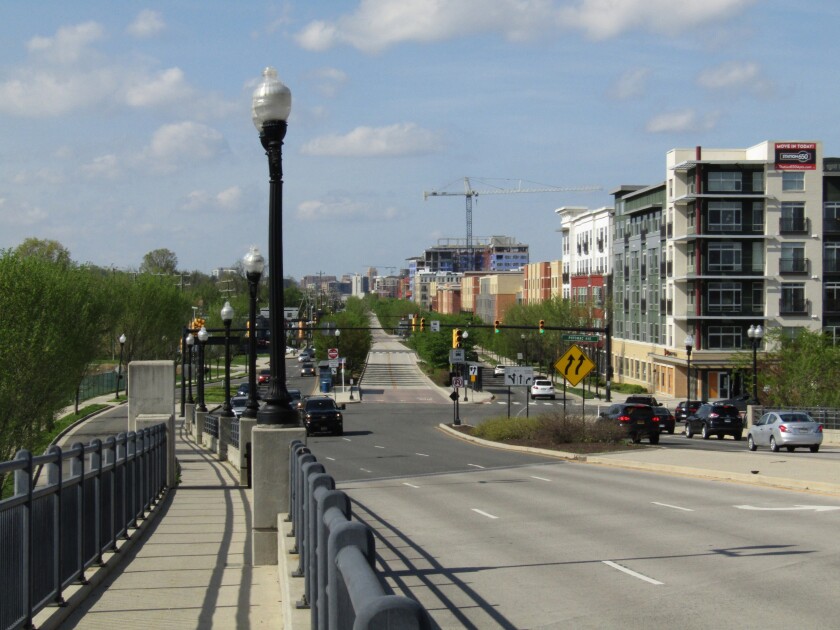Two decades or so later, on the other side of the Atlantic, the communist-led government in Prague got busy doing the same thing. Ideology didn’t much matter. When it came to city planning, bad ideas pushed their way into capitalism and communism alike. Whether right-wing or left, democratic or autocratic, governments embraced the car and the highway as the savior of cities.
I can see these bad ideas in action a short walk from my apartment here in Prague, at the top of Wenceslas Square. There in the 1970s, while putting in a subway system, planners laid down a new highway, some of it on the path of older, more walkable avenues. This highway now carries various names in different sections, including “Wilsonova” in honor of U.S. President Woodrow Wilson. But locally it is called “the Magistrala,” which means “the artery.”
Elevated in sections, the Magistrala starts with a bridge across the Vltava River, then cruises over surface streets before sandwiching between two roadways some of the city’s premier cultural and civic institutions, including the central train station, the state opera house, and the National Museum. Most of these are grand 19th century buildings now semi-cut off from the rest of the city. Prague is known for its beautiful historic streets, and right on the edge of these old streets is this mammoth highway. Tourist write-ups don’t usually mention this.
Of the buildings and places cut off, the most significant is the National Museum, which sits at the top of Wenceslas Square, just begging people to walk up for a visit. When they get there, though, they have to cross what is in effect a motorway, although there are crosswalks. More a grand street than a square, Wenceslas Square is wide and about 10 blocks long. It is lined with ornate buildings, including many elegant hotels. It is the city’s leading civic space. It’s where dissident Vaclav Havel, the future president, addressed throngs in 1989 to start the Velvet Revolution and the fall of communism. This past March, protesters gathered at Wenceslas Square to protest the Russian invasion of Ukraine. So it’s all the more depressing that at the top of the street, where the museum sits, is a one-way arterial that pedestrians must navigate with caution.

(Alex Marshall)
It’s worth looking at what Prague is trying to do, since the challenge is similar on both sides of the water. It’s going to take several generations at least to repair the damage done by these mid-20th century interventions.
The city of Prague hired Jan Gehl, perhaps the world’s best-known urban repairman, to make recommendations on how to soften and fix the Magistrala. Gehl and his associates finished a study in 2017 and you can see a video of its presentation here. Gehl proposed turning the highway, where possible, into an urban boulevard where moving traffic is a lesser priority. He would make it two-way, plant street trees, and put in bike lanes and more crosswalks.
“Stitch the city back together,” Gehl proposed. Convert what is now a barrier into a thoroughfare that attracts people to and through it with various nodes of activity. Do the easier and cheaper things first, and once political momentum is gathered, do more expensive and transformative projects, like tearing down some of the elevated sections.
The report carries weight in part because Gehl and his team look at the highway and its surroundings with depth and subtlety. They note that it runs along the path of the old city walls of Prague, which, as happened in many cities in Europe, were torn out in the 19th century after they ceased to play a role in defense. Vienna is famous for ripping its walls out in the 1850s and putting in the “Ringstrasse,” an elegant circular boulevard lined with apartment buildings. Prague tried to do something like this in the late 19th century but could not manage to get funding and permissions from the city’s Hapsburg Empire overseers. So it’s helpful to learn that Prague’s trouble with this area did not begin in the 1970s.
But while the report is well done, that doesn’t make its solutions any easier. The Magistrala is a functioning roadway. Thousands of commuters doubtless will protest making it into more of a pleasure street. There are also buildings that have grown up around the highway, particularly outside of town, where it connects with a regional freeway. Some of these patterns can’t be undone. That’s why it makes sense to do the easier parts first.
Prague is already following some of Gehl’s advice. This has created some tension between the city and the national government, which is sometimes less interested in urban solutions.
But in the long term, change favors re-urbanizing this part of Prague. There is valuable real estate being underused along this highway. It is a sign of the resiliency and health of cities that they have managed to reknit and repair themselves after the wounds put in by roadways like the Magistrala. With a bit more effort, cities can do even better, in Europe and in America as well.












